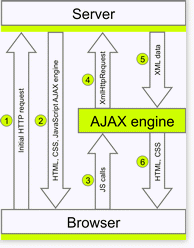What is AJAX
The core idea behind AJAX is to make the communication with the server asynchronous, so that data is transferred and processed in the background. As a result the user can continue working on the other parts of the page without interruption. In an AJAX-enabled application only the relevant page elements are updated and only when necessary.In contrast, the traditional synchronous (postback-based) communication requires a full page reload each time data is transferred to/from the server. This leads to the following negative effects:
-
Poor Interactivity - the user interaction with the application is interrupted by a postback every time a server call is needed.
-
Ineffectiveness - the full page is rendered and transferred to the client on each postback. This process is time consuming and traffic intensive.
-
Low Usability - the requirement for full page postback whenever the user interface is changed imposes hefty limitations on the degree of sophistication a web user interface can achieve. Before AJAX, rich and smooth interfaces with on-demand updates could only be implemented using Flash technology.
AJAX-enabled applications, on the other hand, rely on a new asynchronous method of client-server communication. It is implemented as a JavaScript engine that is loaded on the client during the initial page load. From there on, this engine serves as a mediator that sends only relevant XML-formatted data to the server and subsequently processes the server response to update the relevant page elements.
Below is a diagram of the complete lifecycle of an AJAX-enabled web form.

-
Initial request by the browser – the user requests a particular URL
-
The complete page is rendered by the server (along with the JavaScript AJAX engine) and sent to the client (HTML, CSS, JavaScript AJAX engine)
-
All subsequent requests to the server are initiated as function calls to the JavaScript engine
-
The JavaScript engine then makes an XmlHttpRequest to the server
-
The server processes the request and sends a response in XML format to the client (XML document). It contains the data only of the page elements that need to be changed. In most cases this data comprises just a fraction of the total page markup
-
The AJAX engine processes the server response, updates the relevant page content or performs another operation with the new data received from the server. (HTML + CSS)
AJAX development however is a quite complex process. It requires:
-
Intensive JavaScript coding - this may turn to be a problem for a large number of .Net developers. Furthermore, the lack of good debugging tools for client-side script makes the process even more complicated
-
Comprehensive knowledge of the ASP.NET page lifecycle - AJAX applications typically break the normal page life-cycle and do not work properly. As a result developers have to handle ViewState management, EventValidation, and preservation of client-scripts
The Telerik RadAjax framework eliminates those challenges. The product features Telerik Click-and-Go™ patent-pending technology, which allow you to jump-start your AJAX development today:
-
AJAX-enable any existing or new application, regardless of its level of complexity
-
You don't need detailed knowledge of AJAX
-
You don't have to modify your application - you do not need to place Update Panels, set triggers, manually invoke AJAX requests, etc.
-
You don't have to write a single line of code (JavaScript or server-side)